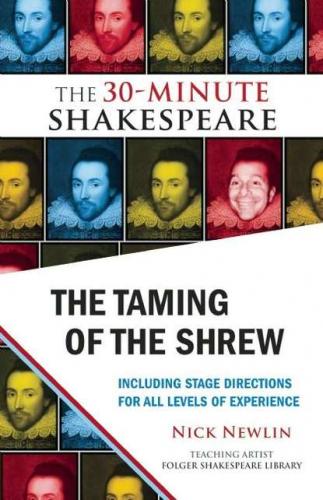THE 30-MINUTE SHAKESPEARE
THE TAMING OF THE SHREW
“Nick Newlin’s work as a teaching artist for Folger Education during the past thirteen years has provided students, regardless of their experience with Shakespeare or being on stage, a unique opportunity to tread the boards at the Folger Theatre. Working with students to edit Shakespeare’s plays for performance at the annual Folger Shakespeare Festivals has enabled students to gain new insights into the Bard’s plays, build their skills of comprehension and critical reading, and just plain have fun working collaboratively with their peers.
Folger Education promotes performance-based teaching of Shakespeare’s plays, providing students with an interactive approach to Shakespeare’s plays in which they participate in a close reading of the text through intellectual, physical, and vocal engagement. Newlin’s The 30-Minute Shakespeare series is an invaluable resource for teachers of Shakespeare, and for all who are interested in performing the plays.”
ROBERT YOUNG, PH.D.
DIRECTOR OF EDUCATION
FOLGER SHAKESPEARE LIBRARY
The Taming of the Shrew: The 30-Minute Shakespeare
ISBN 978-1-935550-33-4
Adaptation, essays, and notes © 2014 by Nick Newlin
No part of this publication may be reproduced or transmitted in any form, electronic, photocopying or otherwise, without the prior written permission of the publisher.
Cover design by Sarah Juckniess
Printed in the United States of America
Distributed by Consortium Book Sales & Distribution
NICOLO WHIMSEY PRESS
Art Director: Sarah Juckniess
Managing Editors: Katherine Little, Leah Gordon
A PLEASANT CONCEITED HISTORIE
CALLED
THE TAMING OF
THE SHREW
THE 30-MINUTE SHAKESPEARE
Written by WILLIAM SHAKESPEARE
Abridged AND Edited
by NICK NEWLIN
To my grandfather
E. Mortimer Newlin
(“Grampa”)
Who loved
a good laugh
Special thanks to Joanne Flynn, Bill Newlin, Eliza Newlin Carney, William and Louisa Newlin, Michael Tolaydo, Hilary Kacser, Sarah Juckniess, Katherine Little, Eva Zimmerman, Leah Gordon, Tanya Tolchin, Frank Harris, Julie Schaper and all of Consortium, Leo Bowman and the students, faculty, and staff at Banneker Academic High School, Charlie Feeser, and Robert Young Ph.D. and the Folger Shakespeare Library, especially the wonderful Education Department.
Preface: No Experience Necessary
Performance Notes: The Taming of the Shrew
I was not a big “actor type” in high school, so if you weren’t either, or if the young people you work with are not, then this book is for you. Whether or not you work with “actor types,” you can use this book to stage a lively and captivating thirty-minute version of a Shakespeare play. No experience is necessary.
When I was about eleven years old, my parents took me to see Shakespeare’s Two Gentlemen of Verona, which was being performed as a Broadway musical. I didn’t comprehend every word I heard, but I was enthralled with the language, the characters, and the story, and I understood enough of it to follow along. From then on, I associated Shakespeare with fun.
Of course Shakespeare is fun. The Elizabethan audiences knew it, which is one reason he was so popular. It didn’t matter that some of the language eluded them. The characters were passionate and vibrant, and their conflicts were compelling. Young people study Shakespeare in high school, but more often than not they read his work like a text book and then get quizzed on academic elements of the play, such as plot, theme, and vocabulary. These are all very interesting, but not nearly as interesting as standing up and performing a scene! It is through performance that the play comes alive and all its “academic” elements are revealed. There is nothing more satisfying to a student or teacher than the feeling of “owning” a Shakespeare play, and that can only come from performing it.
But Shakespeare’s plays are often two or more hours long, making the performance of an entire play almost out of the question. One can perform a single scene, which is certainly a good start, but what about the story? What about the changes a character goes through as the play progresses? When school groups perform one scene unedited, or when they lump several plays together, the audience can get lost. This is why I have always preferred to tell the story of the play.
The 30-Minute Shakespeare gives students and teachers a chance to get up on their feet and act out a Shakespeare play in half an hour, using his language. The emphasis is on key scenes, with narrative bridges between scenes to keep the audience caught up on the action. The stage directions are built into this script so that young actors do not have to stand in one place; they can move and tell the story with their actions as well as their words. And it can all be done in a classroom during class time!
That is where this book was born: not in a research library, a graduate school lecture, a professional stage, or even an after-school drama club. All of the play cuttings in The 30-Minute Shakespeare were first rehearsed in a D.C. public high school English class, and performed successfully at the Folger Shakespeare Library’s annual Secondary School Shakespeare Festival. The players were not necessarily “actor types.” For many of them, this was their first performance in a play.
Something almost miraculous happens when students perform Shakespeare. They “get” it. By occupying the characters and speaking the words out loud, students gain a level of understanding and appreciation that is unachievable by simply reading the text. That is the magic of a performance-based method of learning Shakespeare,
